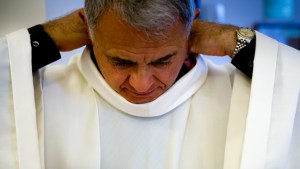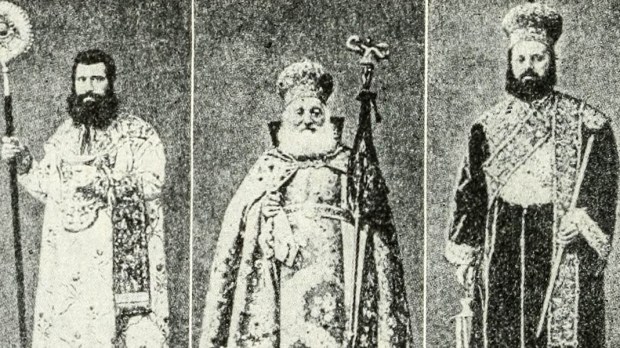Wearing vestments at liturgical ceremonies dates back to the Old Testament and the Jewish practice of wearing special garb for religious events influenced the early Church. However, Christian vestments were not so much adaptions of Old Testament practices, but were more or less copied from the dress of the Greco-Roman world
In the early Christian Church, priests and other clergy wore the same type of clothing as everyone else. But when celebrating Mass or conducting other liturgical ceremonies, they were required to make sure their clothes were pure and clean.
The 4th century saw the beginnings of the vestments we see today. By the early 9th century, rules for vesting were more or less set in place. And, by the 13th century, the Catholic Church had set in place the vesting process which, except for minor changes, has lasted more or less up to the present time.
Altar servers and sacristans have long been versed in the rubrics for vestments, preparing the day’s vestments for the priest. Here is what they prepare for the priest to get ready to celebrate the Eucharist, and some Biblical references that are often used for the special prayers a priest prays as he vests:

Read more:
These vesting prayers before Mass remind priests of their unique vocation
The amice is used to cover the collar of street wear. Today it is mostly used by priests celebrating the Extraordinary Form of the Mass. The Alb can be used to cover the collar instead of wearing the Amice. Originally used as a head covering, a Biblical reference is from Ephesians 6:17: “And take the helmet of salvation and the sword of the Spirit which is God.”
The alb is the long white garment that covers the priest from the neck down to his feet. It is white to symbolize freedom from sin and purity in life. From the Book of Revelation 7:14: we have, “These are the ones who have survived the great period of trial; they have washed their robes and made them white in the blood of the Lamb.”
The cincture is the long cord with tassels on the end that the priest ties around his waist to hold the alb in place. Unlike the stole this can be white or the color of the vestments. This reminds the priest of the quote from 1 Peter 1:13: “Therefore gird up the loins of your mind, live soberly and set your hopes completely on the grace to be brought to you at the revelation of Jesus Christ.”
The next item is the stole, which is placed around the neck, and comes down the shoulders over the alb. It hangs down beyond the waist. It may be crisscrossed across the chest, which symbolizes the Cross. The stole is the same color as the chasuble. It reminds the priest to preach the word of God with courage and conviction. A biblical reference is Hebrews 4:12: “Indeed, the word of God is living and effective, sharper than any two-edged sword, penetrating between even soul and spirit, joint and marrow, and able to discern reflections and thoughts of the heart.”
The chasuble is the outermost garment that only a priest or bishop may wear, and only during Mass. It covers and embraces all underneath it. A biblical reference is in Colossians 3:14: “And over all these put on love, that is, the bond of perfection.”
There is one more piece, called the maniple. This is similar to a large handkerchief that hangs over the left forearm. It is the same color as the other vestments. It stopped being used after 1969, except by those who are celebrating the Extraordinary Form of the Mass.
Various other vestments are used in liturgical services such as Benediction and processions.

